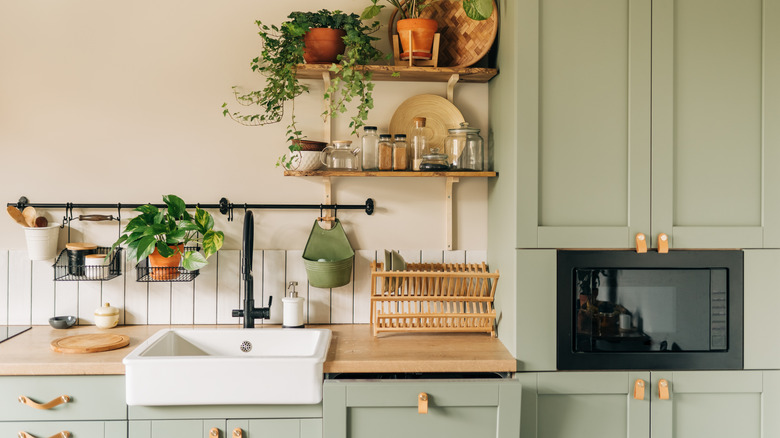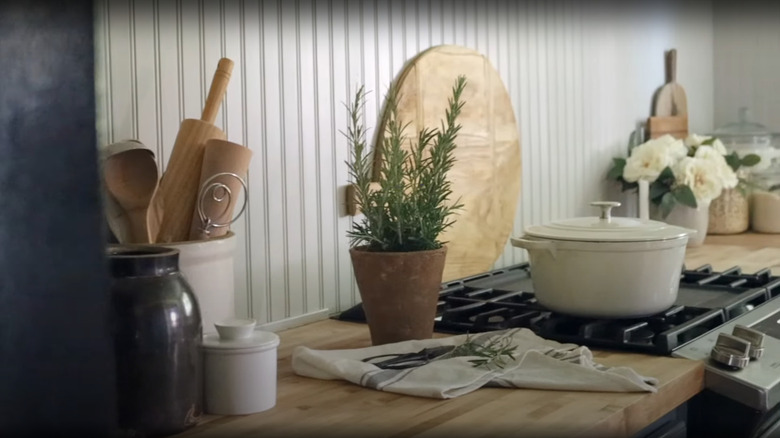Try This Out-Of-The-Box Backsplash For A Rustic Country Kitchen Look
A kitchen backsplash can make or break the overall aesthetic of your kitchen. You've got popular, natural styles like ceramic, or tiles like zellige or diamond that give your kitchen a more vintage vibe. One increasingly popular interior design style is rustic country; think homely character, farmhouse charm, and handcrafted textures. A slightly unconventional, lesser-used material you can use to achieve this rustic effect is beadboard, a type of paneling that originated in the late-Victorian era to protect walls whilst also adding visual character. To delve deeper into why beadboard is such a strong alternative to more conventional backsplashes, Food Republic consulted Ben Kuhl, home remodeler and CEO of Shelf Expression.
"One of the nice things about beadboard is that it provides warmth and texture to a kitchen," Kuhl exclusively tells us. This character comes from the tongue and groove boards on each individual panel, which together give a sophisticated yet handcrafted effect. The result is a backsplash that feels both intentional and timeless. Beadboard can also make smaller kitchens feel more spacious "because the vertical lines add height and draw the eye upward," Kuhl explains. For an even greater sense of height, opt for narrower boards. Panel widths vary depending on style, and many different styles exist.
"Another advantage of beadboard is that it's lightweight, very budget-friendly compared to traditional backsplashes, and easy to install," Kuhl says. It's also simple to remove if you decide to update your kitchen later. And while beadboard is traditionally made of wood, more affordable options like fiberboard or laminate are widely available.
Beadboard that lasts and looks elevated
In a working kitchen, things can get hot, wet, and stained. Beadboard, usually made of porous wood or wood-based materials, can quickly soak up moisture and stains if left untreated, leading to rot and warping. Painted surfaces are also vulnerable, as steam from boiling pots or dishwashers can degrade finishes if the proper steps aren't taken.
To best maintain your beadboard, home remodeler Ben Kuhl recommends, "Make sure to prime and paint with durability in mind, use an oil-based primer and an enamel paint. It's also important to choose either semi-gloss or satin for the sheen, since these finishes repel moisture better than matte." Oil-based primers seal wood, blocking stains and preventing water from entering, while enamel paint dries to a hard, durable finish that resists moisture. Semi-gloss or satin sheens contain resin, making them smoother and easier to wipe clean. Kuhl also stresses regular upkeep, saying, "Wipe [the beadboard] down after cooking with a damp cloth and mild soap. Avoid abrasive materials like scrubbers or Brillo pads, which can scratch the paint. Every few years, touch up the paint and reapply the sealer to keep it looking fresh." If your beadboard is made of wood, also keep in mind that this makes it one of the kitchen surfaces you shouldn't clean with vinegar.
To elevate the look of your beadboard backsplash, Kuhl suggests, "Add trim or molding around the beadboard to make it feel like a designed paneling feature rather than an afterthought." Adding a trim instantly gives the beadboard a sense of intentionality, transforming it from a basic backsplash into a standout design element. You can play with the style of molding to match your kitchen's aesthetic, such as ornate, layered trims for a touch of Victorian elegance, or keep it minimal and streamlined for a modern, no-fuss look.


